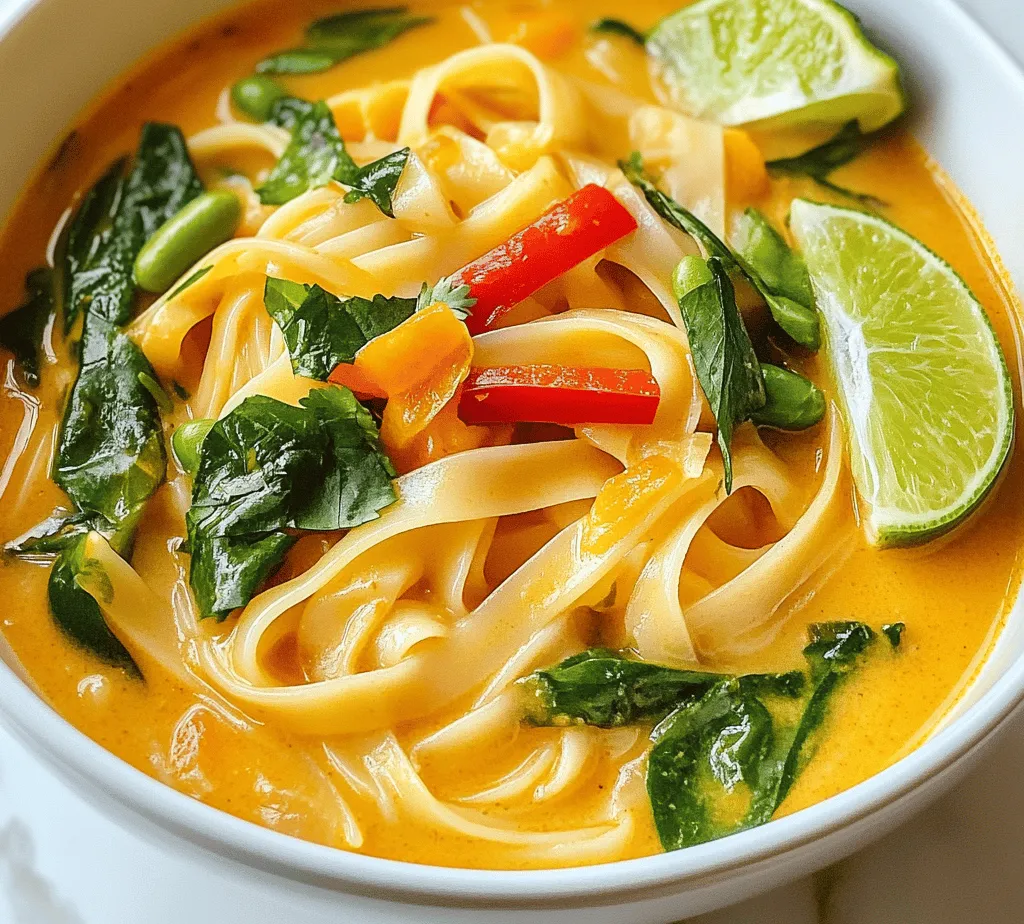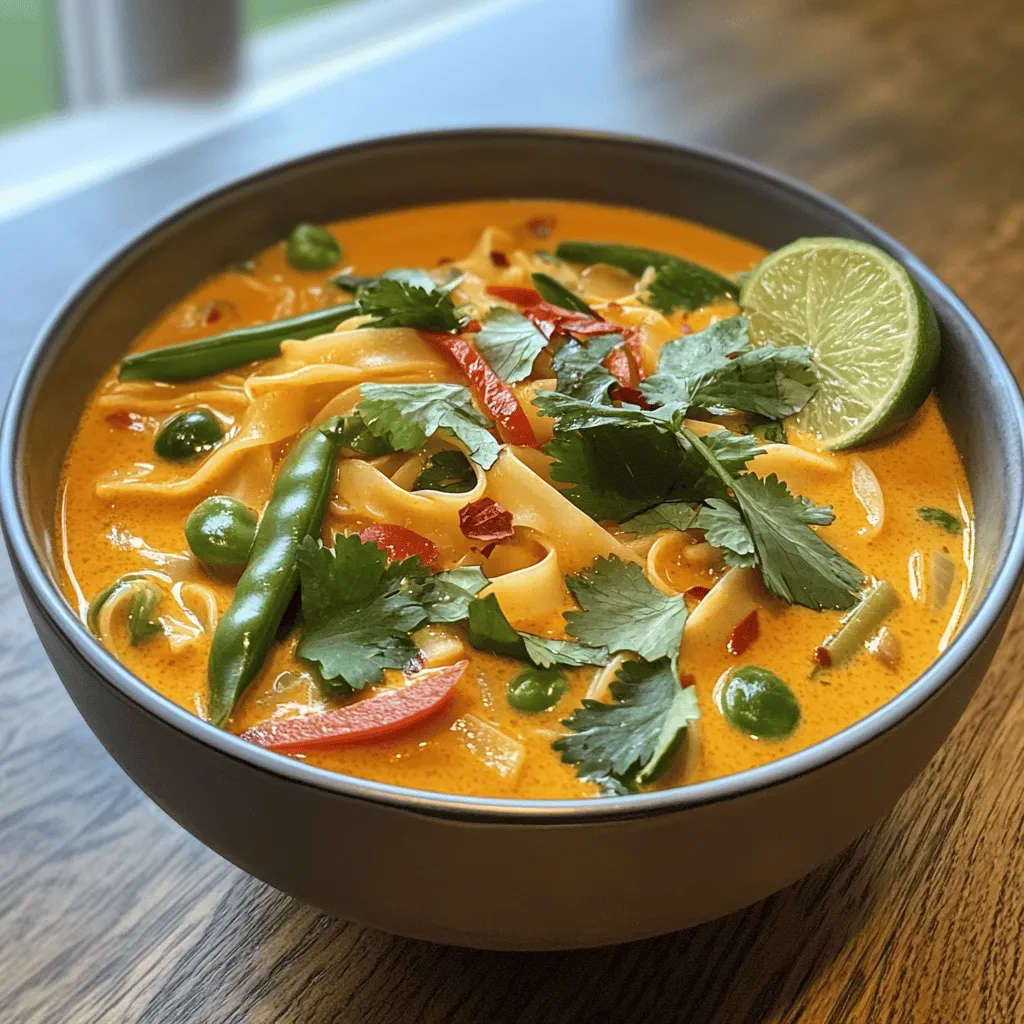Introduction
Thai cuisine is renowned for its vibrant flavors, aromatic herbs, and the perfect balance between sweet, sour, salty, and spicy elements. With its colorful dishes and bold tastes, it’s no wonder that Thai food has gained a loyal following around the globe. Among the myriad of options available, Spicy Thai Red Curry Noodle Soup stands out as a comforting dish that warms the soul. This delightful soup offers a harmonious blend of flavors, making it a staple in many Thai households.
Spicy Thai Red Curry Noodle Soup is not just a meal; it’s an experience. The warmth of the red curry paste, the creaminess of coconut milk, and the freshness of vegetables come together in a bowl that is both nourishing and satisfying. This dish is particularly appealing because it allows for customization based on personal taste preferences. Whether you prefer it mild or with an extra kick, this soup can be tailored to suit any palate.
The balance of ingredients in this recipe not only contributes to its incredible flavor but also brings a wealth of health benefits. Fresh vegetables add essential nutrients, while the inclusion of coconut milk provides a source of healthy fats. Together, they create a dish that is both indulgent and wholesome—perfect for a cozy dinner or a quick weeknight meal.
Understanding the Core Ingredients
To create a truly exceptional Spicy Thai Red Curry Noodle Soup, it is essential to understand the key ingredients that make this dish shine. From the rice noodles to the red curry paste and fresh vegetables, each component plays a crucial role in achieving the perfect balance of flavors and textures.
Rice Noodles
At the heart of this soup are the rice noodles, which serve as the foundation of the dish. These noodles are a staple in Thai cuisine, prized for their light texture and ability to absorb the flavors of the broth. There are several types of rice noodles available, including wide flat noodles (often used in Pad Thai) and thin vermicelli noodles. For this recipe, medium-width rice noodles are ideal as they provide a satisfying bite without overpowering the other ingredients.
Nutritional Benefits and Gluten-Free Options
One of the significant advantages of rice noodles is that they are naturally gluten-free, making them an excellent choice for those with gluten sensitivities. They are also low in calories and fat, while providing a good source of carbohydrates—perfect for an energy-boosting meal. Additionally, rice noodles are easy to cook; they typically require just a brief soak in hot water to achieve the desired texture.
Thai Red Curry Paste
Next up is the star of the show: Thai red curry paste. This vibrant paste is a blend of fresh herbs and spices, including red chilies, garlic, lemongrass, galangal, kaffir lime leaves, and shrimp paste. The combination of these ingredients creates a complex flavor profile that is both aromatic and spicy.
Variations in Spiciness
When selecting a red curry paste, it’s essential to consider the level of spiciness you’re comfortable with. Different brands offer varying degrees of heat, so it’s a good idea to start with a milder paste and adjust the quantity based on your taste preferences. Remember, you can always add more spice, but it can be challenging to tone it down once added.
Coconut Milk
Coconut milk is another essential ingredient in Spicy Thai Red Curry Noodle Soup. It adds a rich creaminess that balances the heat from the curry paste. There are two main types of coconut milk available: full-fat and light. Full-fat coconut milk provides a thicker, creamier texture, while light coconut milk is a lower-calorie option that still delivers a delightful flavor.
Health Benefits
Coconut milk is packed with medium-chain triglycerides (MCTs), a type of healthy fat that can provide a quick source of energy. It is also rich in vitamins and minerals, including magnesium, potassium, and iron. The creamy consistency of coconut milk enhances the soup, making it a comforting choice for chilly evenings.
Fresh Vegetables
No soup is complete without a medley of fresh vegetables, and in this recipe, we focus on red bell pepper, sugar snap peas, and baby spinach. Each of these vegetables brings its unique flavor and nutritional benefits to the dish.
- Red Bell Pepper: Known for its sweetness and vibrant color, red bell pepper adds a crunchy texture and is rich in vitamin C, which supports the immune system.
- Sugar Snap Peas: These peas provide a delightful crunch and are a good source of fiber, vitamins A and C, and iron. Their natural sweetness complements the spicy notes in the soup.
- Baby Spinach: A nutritional powerhouse, baby spinach is packed with vitamins A and K, as well as iron and antioxidants. It wilts beautifully into the soup, providing a fresh, leafy element.
Incorporating these fresh vegetables not only enhances the visual appeal of the soup but also boosts its nutritional profile, making it a well-rounded meal.
Step-by-Step Cooking Instructions
Now that we’ve explored the essential ingredients, let’s dive into the step-by-step process of preparing Spicy Thai Red Curry Noodle Soup. This recipe is designed to be straightforward and accessible, allowing even novice cooks to create a delicious, restaurant-quality meal at home.
Preparation Process
1. Gather Your Ingredients: Start by assembling all the necessary ingredients. This includes rice noodles, Thai red curry paste, coconut milk, fresh vegetables (red bell pepper, sugar snap peas, and baby spinach), garlic, ginger, and onions. Having everything ready will streamline the cooking process.
2. Cook the Rice Noodles: To achieve the perfect texture, bring a pot of water to a boil. Add the rice noodles and cook according to the package instructions, usually around 4-5 minutes. Once cooked, drain and rinse the noodles under cold water to prevent them from sticking together. Set them aside for later use.
3. Sauté Aromatics: In a large pot or Dutch oven, heat a splash of oil over medium heat. Add finely chopped onions and sauté until they become translucent, about 3-4 minutes. Next, add minced garlic and ginger, cooking for an additional 1-2 minutes until fragrant. This step is crucial for building a flavor base for your soup.
4. Combine Ingredients: Once the aromatics are ready, it’s time to add the Thai red curry paste. Stir in the paste, allowing it to cook for a minute to release its essential oils and deepen its flavor. Then, slowly pour in the coconut milk, stirring continuously to combine. Bring the mixture to a gentle simmer.
5. Simmer for Depth of Flavor: After combining the coconut milk and curry paste, add the fresh vegetables—sliced red bell pepper and sugar snap peas. Allow the soup to simmer for about 5 minutes, letting the flavors meld together while the vegetables soften slightly. The vibrant colors of the vegetables will shine through, making the soup visually appealing.
6. Final Touches: After simmering, add the cooked rice noodles and baby spinach to the pot. Stir gently to combine, allowing the spinach to wilt into the soup. Let it simmer for another 2-3 minutes to heat everything through. The final result should be a comforting bowl of spicy, creamy goodness, ready to be enjoyed.
As you prepare this Spicy Thai Red Curry Noodle Soup, you’ll find that the process is as enjoyable as the final dish. The aromas wafting from your kitchen will certainly whet your appetite, making it a delightful cooking experience!



